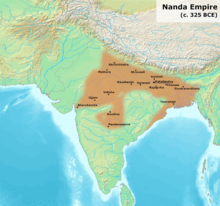The conquest of the Nanda Empire was a war fought in ancient India in the late 4th century BCE (between c. 323 to 321 BCE) between the Nanda Emperor Dhana Nanda and by a force under Chandragupta Maurya led to the establishment of the Maurya Empire. In this war Chanakya was the mentor of Chandragupta Maurya. Little is known from historical sources for certain dating about the conflict.
Quick Facts Date, Location ...
Close
Chandragupta's ancestry is unknown. The knowledge of statecraft and warfare was taught to Chandragupta by his teacher Chanakya, who is referred to as Kautilya. Kautilya's Arthasastra was a science of politics intended to teach a wise king how to govern.[10] Chanakya taught the young emperor a wide-ranging discussions on war and diplomacy. Chanakya's work included; his wish to have his emperor become a world conqueror, his analysis of which kingdoms are natural allies and which are inevitable enemies, his willingness to make treaties he knew he would break and retain, his doctrine of silent war or a war of assassination against an unsuspecting king, his approval of secret agents who killed enemy leaders and sowed discord among them, his views of men and women as weapons of war, his use of religion and superstition to bolster his troops and demoralize enemy soldiers, the spread of disinformation, and his humane treatment of conquered soldiers and subjects.[11]
Much of what is known about the conquest comes from accounts written long after the war itself. Ancient historian Plutarch gives an account of parts of the conquest.[12] The conquest was fictionalized in Mudrarakshasa, a political drama in Sanskrit by Vishakadatta composed between 300 CE and 700 CE.[13] The history is also briefly recounted in Vishnu Purana (unknown date), which emphasizes the importance of Chanakya in the destruction of the Nanda empire.[14] In another work, Milinda Panha (dating from 100 BCE), Bhaddasala is named as a Nanda general during the conquest.[13]
Estimates of the number of soldiers involved are based in part on ancient Roman sources. Plutarch estimates that Chandragupta's army would later number 600,000 by the time it had subdued all of India,[15] an estimate also given by Pliny (23 AD–79 AD). Pliny and Plutarch also estimated the Nanda Army strength in the east as 200,000 infantry, 80,000 cavalry, 8,000 chariots, and 6,000 war elephants. These estimates were based in part of the earlier work of the Seleucid ambassador to the Maurya, Megasthenes.[16] One 21st-century author, Suhas Chatterjee, suggests that "Chandragupta had to engage all his military strength, even Greek mercenaries from Punjab in his conquest of the Nanda king" and according to references about the conquest in the Milinda Panha "100,000 of soldiers, 10,000 elephants, 100,000 horses and 5,000 charioteers were killed in the encounter".[17]
In Mudrarakshasa, Chandragupta was said to have first acquired Punjab, and then combined forces with Chanakya and advanced upon the Nanda Empire.[13] Similarly, Plutarch writes that he first overthrew Alexanders Prefects in the northwest of India.[12] P. K. Bhattacharyya concludes that the war would have consisted of gradual conquest of provinces after the initial consolidation of Magadha.[15] In Mudrarakshasa, he laid siege to Kusumapura (or Pataliputra, now Patna), the capital of Magadha, with the help of north-west frontier tribe mercenaries from areas already conquered.[13] The siege may have begun in 320 BCE.[18] By 312 BCE he had conquered all of north and north-west India.[13]
In the war, Chandragupta may have allied with the Matsya king and the Suryavamshi king of Kalinga (modern-day Odisha).[19] The prior experience of his mercenaries from the Punjab were likely important in his military success.[20] It is also suggested that Chandragupta's campaign was laid out by using popular guerrilla tactics, as the Nanda Empire was large and had been able to wield large armies that would have been overwhelming to oppose by an upstart.[18] The war brought an end to the Nanda Dynasty and established the Maurya Empire with Chandragupta Maurya as its emperor.
